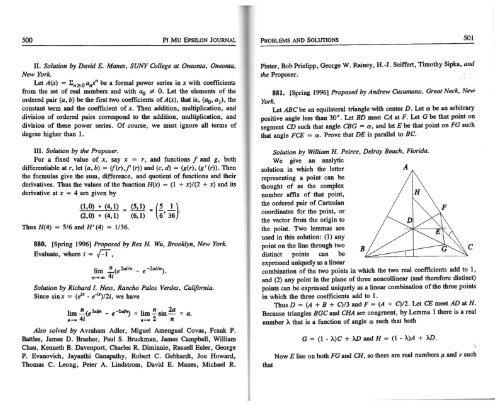Vol. 10 No 6 - Pi Mu Epsilon
Vol. 10 No 6 - Pi Mu Epsilon
Vol. 10 No 6 - Pi Mu Epsilon
- No tags were found...
You also want an ePaper? Increase the reach of your titles
YUMPU automatically turns print PDFs into web optimized ePapers that Google loves.
500 PI MU EPSILON JOURNAL<br />
PROBLEMS AND SOLUTIONS 501<br />
II. Solution by David E. Manes, SUNY College at Oneonta, Oneonta,<br />
New York.<br />
Let A(x) = :tn~oa/ be a formal power series in x with coefficients<br />
from the set of real numbers and with ao ':;i 0. Let the elements of the<br />
ordered pair (a, b) be the first two coefficients of A(x), that is, (Oo, a 1 ), the<br />
constant term and the coefficient of x. Then addition, multiplication, and<br />
division of ordered pairs correspond to the addition, multiplication, and<br />
division of these power series. Of course, we must ignore all terms of<br />
degree higher than 1.<br />
III. Solution by the Proposer.<br />
For a fixed value of x, say x = r, and functions f and g, both<br />
differentiable at r, let {a, b) = if(r),f (r)) and {c, d) = {g{r), {g' (r)). Then<br />
the formulas give the sum, difference, and quotient of functions and their<br />
derivatives. Thus the values of the function H(x) = (1 + x)/(2 + x) and its<br />
derivative at x = 4 are given by<br />
Thus H(4) = 516 and H' (4) = 1/36.<br />
(1,0) + (4,1) _ (5,1) _ (s 1)<br />
(2,0) + (4, 1) - (6, 1) - 6' 36 .<br />
880. [Spring 1996] Proposed by Rex H. Wu, Brooklyn, New York.<br />
Evaluate, where i = H,<br />
lim ~(e2ailn - e -2ailn).<br />
n-OD 4t<br />
Solution by Richard 1. Hess, Rancho Palos Verdes, California.<br />
Since sinx = (tfx - e-ix)/2i, we have<br />
- e - e = - sm- = a.<br />
lim<br />
II ( 2Gi/tt -2Di/") lim II . 2a<br />
,. __ 4i ,. __ 2 n<br />
Also solved by Avraham Adler, Miguel Amengual Covas, Frank P.<br />
Battles, James D. Brasher, Paul S. Bruckman, James Campbell, William<br />
Chau, Kenneth B. Davenport, Charles R. Diminnie, Russell Euler, George<br />
P. Evanovich, Jayanthi Ganapathy, Robert C. Gebhardt, Joe Howard,<br />
Thomas C. Leong, Peter A. Lindstrom, David E. Manes, Michael R.<br />
<strong>Pi</strong>nter, Bob Prielipp, George W. Rainey, H.-J. Seiffert, Timothy Sipka, and<br />
the Proposer.<br />
881. [Spring 1996] Proposed by Andrew Cusumano, Great Neck, New<br />
York.<br />
Let ABC be an equilateral triangle with center D. Let a be an arbitrary<br />
positive angle less than 30°. Let BD meet CA at F. Let G be that point on<br />
segment CD such that angle CBG = a, and let E be that point on FG such<br />
that angle FCE = a. Prove that DE is parallel to BC.<br />
Solution by William H. Peirce, Delray Beach, Florida.<br />
We give an analytic<br />
solution in which the letter<br />
A<br />
representing a point can be<br />
thought of as the complex<br />
number affix of that point,<br />
the ordered pair of Cartesian<br />
coordinates for the point, or<br />
the vector from the origin to<br />
the point. Two lemmas are<br />
used in this solution: (1) any<br />
point on the line through two B C<br />
distinct points can be<br />
expressed uniquely as a linear<br />
combination of the two points in which the two real coefficients add to 1,<br />
and (2) any point in the plane of three noncollinear (and therefore distinct)<br />
points can be expressed uniquely as a linear combination of the three points<br />
in which the three coefficients add to 1.<br />
Thus D =(A + B + C)/3 and F =(A+ C)/2. Let CE meet AD at H.<br />
Because triangles BGC and CHA are congruent, by Lemma 1 there is a real<br />
number A. that is a function of angle a such that both<br />
G = (1 - A.)C + AD and H = (1 - A.)A + AD.<br />
<strong>No</strong>w E lies on both FG and CH, so there are real numbers p. and P such<br />
that
















